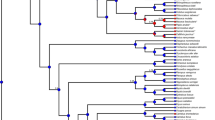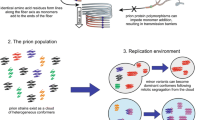Abstract
The prion protein (PrP) when misfolded into the pathogenic conformer PrPSc is the major causative agent of several lethal transmissible spongiform encephalopathies in mammals. Studies of evolutionary pressure on the corresponding gene using different datasets have yielded conflicting results. In addition, putative PrP or PrP interacting partners with strong similarity to PrP such as the doppel protein have not been examined to determine if the same evolutionary mechanisms apply to prion paralogs or if there are coselected sites that might indicate how and where the proteins interact. We examined several taxonomic groups that contain model organisms of prion diseases focusing on primates, bovids, and an expanded dataset of rodents for selection pressure on the prion gene (PRNP) and doppel gene (PRND) individually and for coevolving sites within. Overall, the results clearly indicate that both proteins are under strong selective constraints with relaxed selection on amino acid residues connecting α-helices 1 and 2.




Similar content being viewed by others
References
Abascal F, Zardoya R, Telford MJ (2010) TranslatorX: multiple alignment of nucleotide sequences guided by amino acid translations. Nucleic Acids Res 38:W7–W13
Caputo A, Sarnataro D, Campana V, Costanzo M, Negro A, Sorgato MC, Zurzolo C (2010) Doppel and PrPC co-immunoprecipitate in detergent-resistant membrane domains of epithelial FRT cells. Biochem J 425:341–351
Christen B, Damberger FF, Perez DR, Hornemann S, Wuthrich K (2013) Structural plasticity of the cellular prion protein and implications in health and disease. Proc Natl Acad Sci USA 110:8549–8554
Collinge J (2001) Prion diseases of humans and animals: their causes and molecular basis. Annu Rev Neurosci 24:519–550
Delport W, Poon AF, Frost SD, Kosakovsky Pond SL (2010) Datamonkey 2010: a suite of phylogenetic analysis tools for evolutionary biology. Bioinformatics 26:2455–2457
Doron-Faigenboim A, Pupko T (2007) A combined empirical and mechanistic codon model. Mol Biol Evol 24:388–397
Fares MA, McNally D (2006) CAPS: coevolution analysis using protein sequences. Bioinformatics 22:2821–2822
Fares MA, Travers SA (2006) A novel method for detecting intramolecular coevolution: adding a further dimension to selective constraints analyses. Genetics 173:9–23
Felsenstein J (1981) Evolutionary trees from DNA sequences: a maximum likelihood approach. J Mol Evol 17:368–376
Golaniska E, Flirski M, Liberski PP (2004) Doppel: the prion’s double. Folia Neuropathol 42(Suppl A):47–54
Heisey DM, Mickelsen NA, Schneider JR, Johnson CJ, Langenberg JA, Bochsler PN, Keane DP, Barr DJ (2010) Chronic wasting disease (CWD) susceptibility of several North American rodents that are sympatric with cervid CWD epidemics. J Virol 84:210–215
Hunter N (2007) Scrapie: uncertainties, biology and molecular approaches. Biochim Biophys Acta 1772:619–628
Jones DT, Taylor WR, Thornton JM (1992) The rapid generation of mutation data matrices from protein sequences. Comput Appl Biosci 8:275–282
Kaneko K, Zulianello L, Scott M, Cooper CM, Wallace AC, James TL, Cohen FE, Prusiner SB (1997) Evidence for protein X binding to a discontinuous epitope on the cellular prion protein during scrapie prion propagation. Proc Natl Acad Sci USA 94:10069–10074
Katoh K, Standley DM (2013) MAFFT multiple sequence alignment software version 7: improvements in performance and usability. Mol Biol Evol 30:772–780
Kosakovsky Pond SL, Frost SD (2005) Not so different after all: a comparison of methods for detecting amino acid sites under selection. Mol Biol Evol 22:1208–1222
Kosakovsky Pond SL, Murrell B, Fourment M, Frost SD, Delport W, Scheffler K (2011) A random effects branch-site model for detecting episodic diversifying selection. Mol Biol Evol 28:3033–3043
Krakauer DC, Zanotto PM, Pagel M (1998) Prion’s progress: patterns and rates of molecular evolution in relation to spongiform disease. J Mol Evol 47:133–145
Kraus A, Groveman BR, Caughey B (2013) Prions and the potential transmissibility of protein misfolding diseases. Annu Rev Microbiol 67:543–564
Kreitman M, Di Rienzo A (2004) Balancing claims for balancing selection. Trends Genet 20:300–304
Lanave C, Preparata G, Saccone C, Serio G (1984) A new method for calculating evolutionary substitution rates. J Mol Evol 20:86–93
Martin R, Gallet PF, Rocha D, Petit D (2009) Polymorphism of the prion protein in mammals: a phylogenetic approach. Recent Pat DNA Gene Seq 3:63–71
Mastrangelo P, Westaway D (2001) The prion gene complex encoding PrP(C) and Doppel: insights from mutational analysis. Gene 275:1–18
Mead S, Stumpf MP, Whitfield J, Beck JA, Poulter M, Campbell T, Uphill JB, Goldstein D, Alpers M, Fisher EM, Collinge J (2003) Balancing selection at the prion protein gene consistent with prehistoric kurulike epidemics. Science 300:640–643
Murrell B, Wertheim JO, Moola S, Weighill T, Scheffler K, Pond SL (2012) Detecting individual sites subject to episodic diversifying selection. PLoS Genet 8:e1002764
Murrell B, Moola S, Mabona A, Weighill T, Sheward D, Pond SLK, Scheffler K (2013) FUBAR: a fast, unconstrained bayesian approximation for inferring selection. Mol Biol Evol 30:1196–1205
Perrier V, Kaneko K, Safar J, Vergara J, Tremblay P, DeArmond SJ, Cohen FE, Prusiner SB, Wallace AC (2002) Dominant-negative inhibition of prion replication in transgenic mice. Proc Natl Acad Sci USA 99:13079–13084
Pond SL, Frost SD, Muse SV (2005) HyPhy: hypothesis testing using phylogenies. Bioinformatics 21:676–679
Premzl M, Gamulin V (2007) Comparative genomic analysis of prion genes. BMC Genomics 8:1
Premzl M, Gamulin V (2009) Positive selection in prion protein. J Mol Evol 68:205–207
Richmond K, Masterson P, Ortiz JF, Siltberg-Liberles J (2014) Did the prion protein become vulnerable to misfolding after an evolutionary divide and conquer event? J Biomol Struct Dyn 32(7):1074–1084
Riek R, Wider G, Billeter M, Hornemann S, Glockshuber R, Wuthrich K (1998) Prion protein NMR structure and familial human spongiform encephalopathies. Proc Natl Acad Sci USA 95:11667–11672
Sakaguchi S (2008) Antagonistic roles of the N-terminal domain of prion protein to doppel. Prion 2:107–111
Saunders SE, Bartelt-Hunt SL, Bartz JC (2012) Occurrence, transmission, and zoonotic potential of chronic wasting disease. Emerg Infect Dis 18:369–376
Schatzl HM, Da Costa M, Taylor L, Cohen FE, Prusiner SB (1995) Prion protein gene variation among primates. J Mol Biol 245:362–374
Seabury CM, Honeycutt RL, Rooney AP, Halbert ND, Derr JN (2004) Prion protein gene (PRNP) variants and evidence for strong purifying selection in functionally important regions of bovine exon 3. Proc Natl Acad Sci USA 101:15142–15147
Silverman GL, Qin KF, Moore RC, Yang Y, Mastrangelo P, Tremblay P, Prusiner SB, Cohen FE, Westaway D (2000) Doppel is an N-glycosylated, glycosylphosphatidylinositol-anchored protein—expression in testis and ectopic production in the brains of Prnp(o/o) mice predisposed to Purkinje cell loss. J Biol Chem 275:26834–26841
Soldevila M, Andres AM, Ramirez-Soriano A, Marques-Bonet T, Calafell F, Navarro A, Bertranpetit J (2006) The prion protein gene in humans revisited: lessons from a worldwide resequencing study. Genome Res 16:231–239
Stamatakis A (2006) RAxML-VI-HPC: maximum likelihood-based phylogenetic analyses with thousands of taxa and mixed models. Bioinformatics 22:2688–2690
van Rheede T, Smolenaars MMW, Madsen O, de Jong WW (2003) Molecular evolution of the mammalian prion protein. Mol Biol Evol 20:111–121
Westaway D, Genovesi S, Daude N, Brown R, Lau A, Lee I, Mays CE, Coomaraswamy J, Canine B, Pitstick R, Herbst A, Yang J, Ko KW, Schmitt-Ulms G, Dearmond SJ, McKenzie D, Hood L, Carlson GA (2011) Down-regulation of Shadoo in prion infections traces a pre-clinical event inversely related to PrP(Sc) accumulation. PLoS Pathog 7:e1002391
Wopfner F, Weidenhofer G, Schneider R, von Brunn A, Gilch S, Schwarz TF, Werner T, Schatzl HM (1999) Analysis of 27 mammalian and 9 avian PrPs reveals high conservation of flexible regions of the prion protein. J Mol Biol 289:1163–1178
Yang Z (1993) Maximum-likelihood estimation of phylogeny from DNA sequences when substitution rates differ over sites. Mol Biol Evol 10:1396–1401
Acknowledgments
We thank the French ANR Biodiversity, Grant ANR 07 BDIV 012 CERoPath project (Community Ecology of Rodents and their Pathogens in a changing environment (www.ceropath.org), and the French ANR CP&ES, Grant ANR 11 CPEL 002 BiodivHealthSEA project (Local impacts and perceptions of global changes: Biodiversity and health in Southeast Asia) (www.biodivhealthsea.org) and all the CERoPath participants for their great help in field works. We also thank the Conservation Genetics Unit of the University of Liège and the Belgian Funds for the Scientific Research (FNRS) for supporting Johan Michaux. The provision of samples and support of the investigations by Jona Freise (Oldenburg), Hanan Sheikh Ali (Greifswald-Insel Riems) are kindly acknowledged. We acknowledge the help of Sergei L. Kosakovsky Pond with the programs HyPhy and Spidermonkey.
Author information
Authors and Affiliations
Corresponding author
Additional information
Kyriakos Tsangaras, Sergios-Orestis Kolokotronis are considered joint first authors.
Electronic supplementary material
Below is the link to the electronic supplementary material.
Rights and permissions
About this article
Cite this article
Tsangaras, K., Kolokotronis, SO., Ulrich, R.G. et al. Negative Purifying Selection Drives Prion and Doppel Protein Evolution. J Mol Evol 79, 12–20 (2014). https://doi.org/10.1007/s00239-014-9632-1
Received:
Accepted:
Published:
Issue Date:
DOI: https://doi.org/10.1007/s00239-014-9632-1




